University Laboratory Hazards: Risk Assessment and Management Report
VerifiedAdded on 2022/09/17
|8
|1373
|34
Report
AI Summary
This report presents a comprehensive risk assessment of laboratory hazards, addressing various potential dangers within a research environment. The report begins with an introduction emphasizing the importance of hazard awareness for all lab personnel, followed by a detailed discussion of different hazard types, including biological, chemical, electrical, biomechanical, and physical environment risks. A risk assessment table is constructed to evaluate the likelihood, consequence, and significance of these hazards. The report then delves into the management of each hazard, suggesting control measures such as engineering controls, substitution, and the use of personal protective equipment (PPE). Additionally, the report includes a second risk assessment table that evaluates the hazards after the implementation of control measures. The report concludes by summarizing the challenges faced in research laboratories and emphasizes the need for appropriate guidelines to reduce accidents and ensure the safety of laboratory workers. References to relevant sources support the analysis and recommendations.
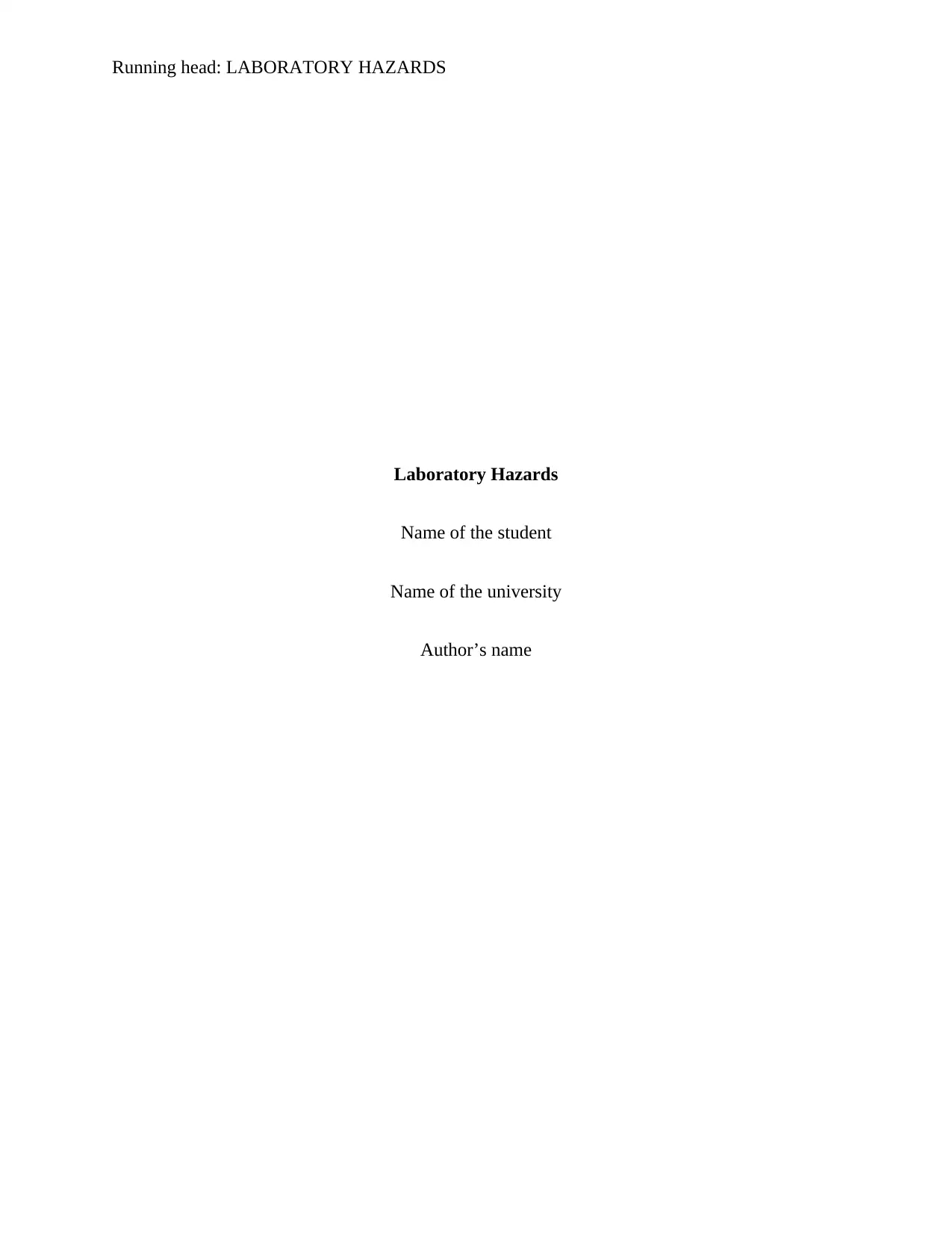
Running head: LABORATORY HAZARDS
Laboratory Hazards
Name of the student
Name of the university
Author’s name
Laboratory Hazards
Name of the student
Name of the university
Author’s name
Paraphrase This Document
Need a fresh take? Get an instant paraphrase of this document with our AI Paraphraser
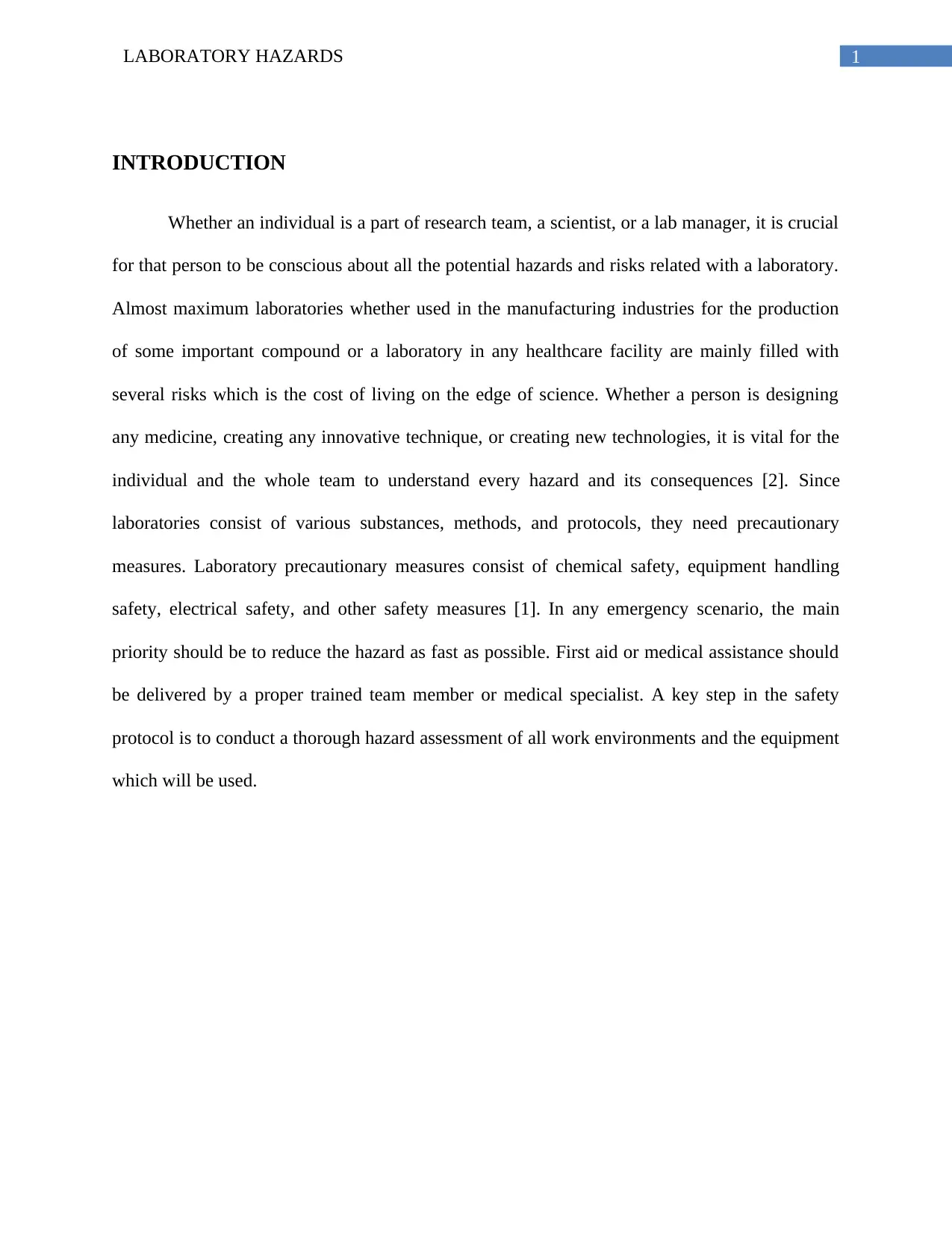
1LABORATORY HAZARDS
INTRODUCTION
Whether an individual is a part of research team, a scientist, or a lab manager, it is crucial
for that person to be conscious about all the potential hazards and risks related with a laboratory.
Almost maximum laboratories whether used in the manufacturing industries for the production
of some important compound or a laboratory in any healthcare facility are mainly filled with
several risks which is the cost of living on the edge of science. Whether a person is designing
any medicine, creating any innovative technique, or creating new technologies, it is vital for the
individual and the whole team to understand every hazard and its consequences [2]. Since
laboratories consist of various substances, methods, and protocols, they need precautionary
measures. Laboratory precautionary measures consist of chemical safety, equipment handling
safety, electrical safety, and other safety measures [1]. In any emergency scenario, the main
priority should be to reduce the hazard as fast as possible. First aid or medical assistance should
be delivered by a proper trained team member or medical specialist. A key step in the safety
protocol is to conduct a thorough hazard assessment of all work environments and the equipment
which will be used.
INTRODUCTION
Whether an individual is a part of research team, a scientist, or a lab manager, it is crucial
for that person to be conscious about all the potential hazards and risks related with a laboratory.
Almost maximum laboratories whether used in the manufacturing industries for the production
of some important compound or a laboratory in any healthcare facility are mainly filled with
several risks which is the cost of living on the edge of science. Whether a person is designing
any medicine, creating any innovative technique, or creating new technologies, it is vital for the
individual and the whole team to understand every hazard and its consequences [2]. Since
laboratories consist of various substances, methods, and protocols, they need precautionary
measures. Laboratory precautionary measures consist of chemical safety, equipment handling
safety, electrical safety, and other safety measures [1]. In any emergency scenario, the main
priority should be to reduce the hazard as fast as possible. First aid or medical assistance should
be delivered by a proper trained team member or medical specialist. A key step in the safety
protocol is to conduct a thorough hazard assessment of all work environments and the equipment
which will be used.
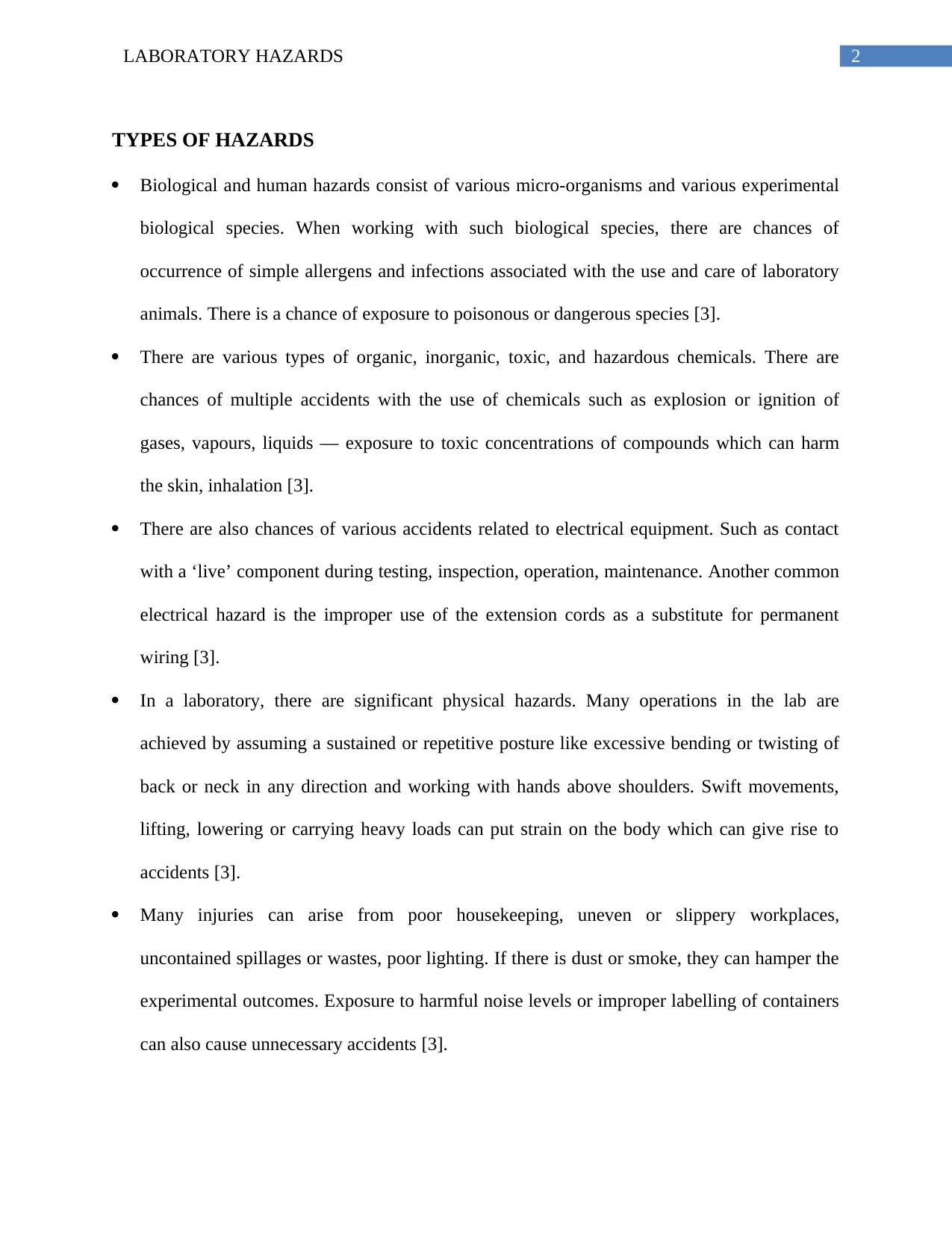
2LABORATORY HAZARDS
TYPES OF HAZARDS
Biological and human hazards consist of various micro-organisms and various experimental
biological species. When working with such biological species, there are chances of
occurrence of simple allergens and infections associated with the use and care of laboratory
animals. There is a chance of exposure to poisonous or dangerous species [3].
There are various types of organic, inorganic, toxic, and hazardous chemicals. There are
chances of multiple accidents with the use of chemicals such as explosion or ignition of
gases, vapours, liquids — exposure to toxic concentrations of compounds which can harm
the skin, inhalation [3].
There are also chances of various accidents related to electrical equipment. Such as contact
with a ‘live’ component during testing, inspection, operation, maintenance. Another common
electrical hazard is the improper use of the extension cords as a substitute for permanent
wiring [3].
In a laboratory, there are significant physical hazards. Many operations in the lab are
achieved by assuming a sustained or repetitive posture like excessive bending or twisting of
back or neck in any direction and working with hands above shoulders. Swift movements,
lifting, lowering or carrying heavy loads can put strain on the body which can give rise to
accidents [3].
Many injuries can arise from poor housekeeping, uneven or slippery workplaces,
uncontained spillages or wastes, poor lighting. If there is dust or smoke, they can hamper the
experimental outcomes. Exposure to harmful noise levels or improper labelling of containers
can also cause unnecessary accidents [3].
TYPES OF HAZARDS
Biological and human hazards consist of various micro-organisms and various experimental
biological species. When working with such biological species, there are chances of
occurrence of simple allergens and infections associated with the use and care of laboratory
animals. There is a chance of exposure to poisonous or dangerous species [3].
There are various types of organic, inorganic, toxic, and hazardous chemicals. There are
chances of multiple accidents with the use of chemicals such as explosion or ignition of
gases, vapours, liquids — exposure to toxic concentrations of compounds which can harm
the skin, inhalation [3].
There are also chances of various accidents related to electrical equipment. Such as contact
with a ‘live’ component during testing, inspection, operation, maintenance. Another common
electrical hazard is the improper use of the extension cords as a substitute for permanent
wiring [3].
In a laboratory, there are significant physical hazards. Many operations in the lab are
achieved by assuming a sustained or repetitive posture like excessive bending or twisting of
back or neck in any direction and working with hands above shoulders. Swift movements,
lifting, lowering or carrying heavy loads can put strain on the body which can give rise to
accidents [3].
Many injuries can arise from poor housekeeping, uneven or slippery workplaces,
uncontained spillages or wastes, poor lighting. If there is dust or smoke, they can hamper the
experimental outcomes. Exposure to harmful noise levels or improper labelling of containers
can also cause unnecessary accidents [3].
⊘ This is a preview!⊘
Do you want full access?
Subscribe today to unlock all pages.

Trusted by 1+ million students worldwide
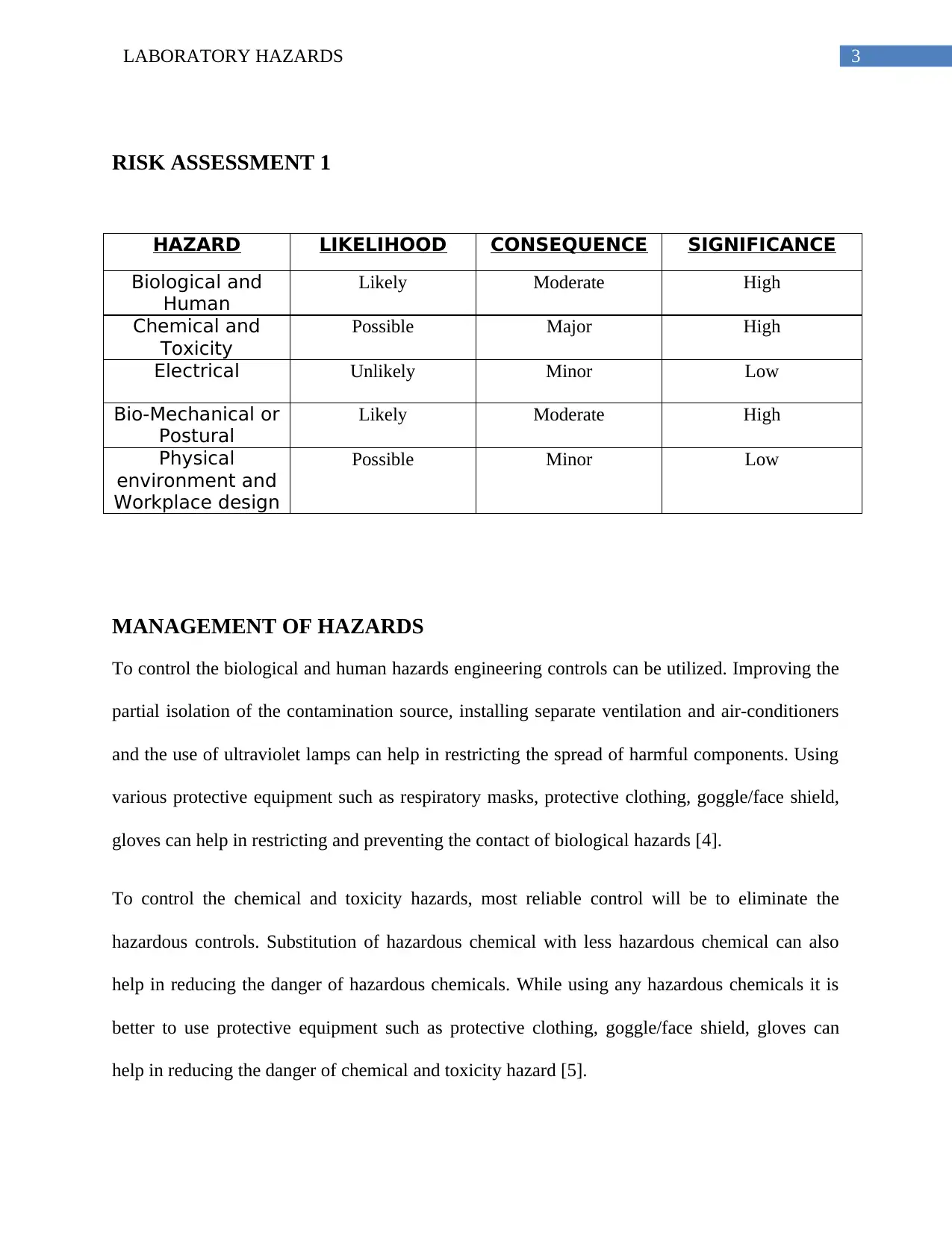
3LABORATORY HAZARDS
RISK ASSESSMENT 1
HAZARD LIKELIHOOD CONSEQUENCE SIGNIFICANCE
Biological and
Human
Likely Moderate High
Chemical and
Toxicity
Possible Major High
Electrical Unlikely Minor Low
Bio-Mechanical or
Postural
Likely Moderate High
Physical
environment and
Workplace design
Possible Minor Low
MANAGEMENT OF HAZARDS
To control the biological and human hazards engineering controls can be utilized. Improving the
partial isolation of the contamination source, installing separate ventilation and air-conditioners
and the use of ultraviolet lamps can help in restricting the spread of harmful components. Using
various protective equipment such as respiratory masks, protective clothing, goggle/face shield,
gloves can help in restricting and preventing the contact of biological hazards [4].
To control the chemical and toxicity hazards, most reliable control will be to eliminate the
hazardous controls. Substitution of hazardous chemical with less hazardous chemical can also
help in reducing the danger of hazardous chemicals. While using any hazardous chemicals it is
better to use protective equipment such as protective clothing, goggle/face shield, gloves can
help in reducing the danger of chemical and toxicity hazard [5].
RISK ASSESSMENT 1
HAZARD LIKELIHOOD CONSEQUENCE SIGNIFICANCE
Biological and
Human
Likely Moderate High
Chemical and
Toxicity
Possible Major High
Electrical Unlikely Minor Low
Bio-Mechanical or
Postural
Likely Moderate High
Physical
environment and
Workplace design
Possible Minor Low
MANAGEMENT OF HAZARDS
To control the biological and human hazards engineering controls can be utilized. Improving the
partial isolation of the contamination source, installing separate ventilation and air-conditioners
and the use of ultraviolet lamps can help in restricting the spread of harmful components. Using
various protective equipment such as respiratory masks, protective clothing, goggle/face shield,
gloves can help in restricting and preventing the contact of biological hazards [4].
To control the chemical and toxicity hazards, most reliable control will be to eliminate the
hazardous controls. Substitution of hazardous chemical with less hazardous chemical can also
help in reducing the danger of hazardous chemicals. While using any hazardous chemicals it is
better to use protective equipment such as protective clothing, goggle/face shield, gloves can
help in reducing the danger of chemical and toxicity hazard [5].
Paraphrase This Document
Need a fresh take? Get an instant paraphrase of this document with our AI Paraphraser
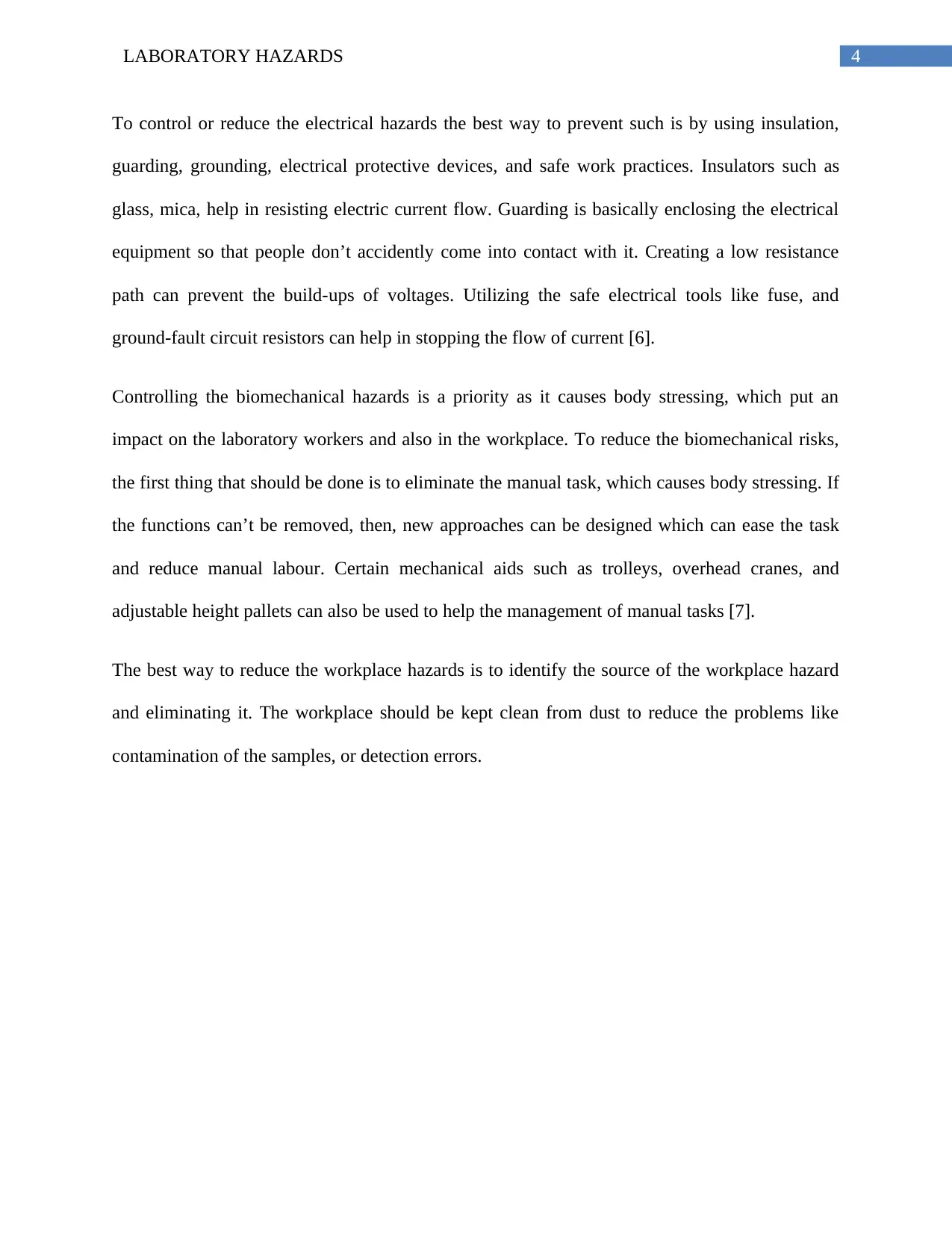
4LABORATORY HAZARDS
To control or reduce the electrical hazards the best way to prevent such is by using insulation,
guarding, grounding, electrical protective devices, and safe work practices. Insulators such as
glass, mica, help in resisting electric current flow. Guarding is basically enclosing the electrical
equipment so that people don’t accidently come into contact with it. Creating a low resistance
path can prevent the build-ups of voltages. Utilizing the safe electrical tools like fuse, and
ground-fault circuit resistors can help in stopping the flow of current [6].
Controlling the biomechanical hazards is a priority as it causes body stressing, which put an
impact on the laboratory workers and also in the workplace. To reduce the biomechanical risks,
the first thing that should be done is to eliminate the manual task, which causes body stressing. If
the functions can’t be removed, then, new approaches can be designed which can ease the task
and reduce manual labour. Certain mechanical aids such as trolleys, overhead cranes, and
adjustable height pallets can also be used to help the management of manual tasks [7].
The best way to reduce the workplace hazards is to identify the source of the workplace hazard
and eliminating it. The workplace should be kept clean from dust to reduce the problems like
contamination of the samples, or detection errors.
To control or reduce the electrical hazards the best way to prevent such is by using insulation,
guarding, grounding, electrical protective devices, and safe work practices. Insulators such as
glass, mica, help in resisting electric current flow. Guarding is basically enclosing the electrical
equipment so that people don’t accidently come into contact with it. Creating a low resistance
path can prevent the build-ups of voltages. Utilizing the safe electrical tools like fuse, and
ground-fault circuit resistors can help in stopping the flow of current [6].
Controlling the biomechanical hazards is a priority as it causes body stressing, which put an
impact on the laboratory workers and also in the workplace. To reduce the biomechanical risks,
the first thing that should be done is to eliminate the manual task, which causes body stressing. If
the functions can’t be removed, then, new approaches can be designed which can ease the task
and reduce manual labour. Certain mechanical aids such as trolleys, overhead cranes, and
adjustable height pallets can also be used to help the management of manual tasks [7].
The best way to reduce the workplace hazards is to identify the source of the workplace hazard
and eliminating it. The workplace should be kept clean from dust to reduce the problems like
contamination of the samples, or detection errors.
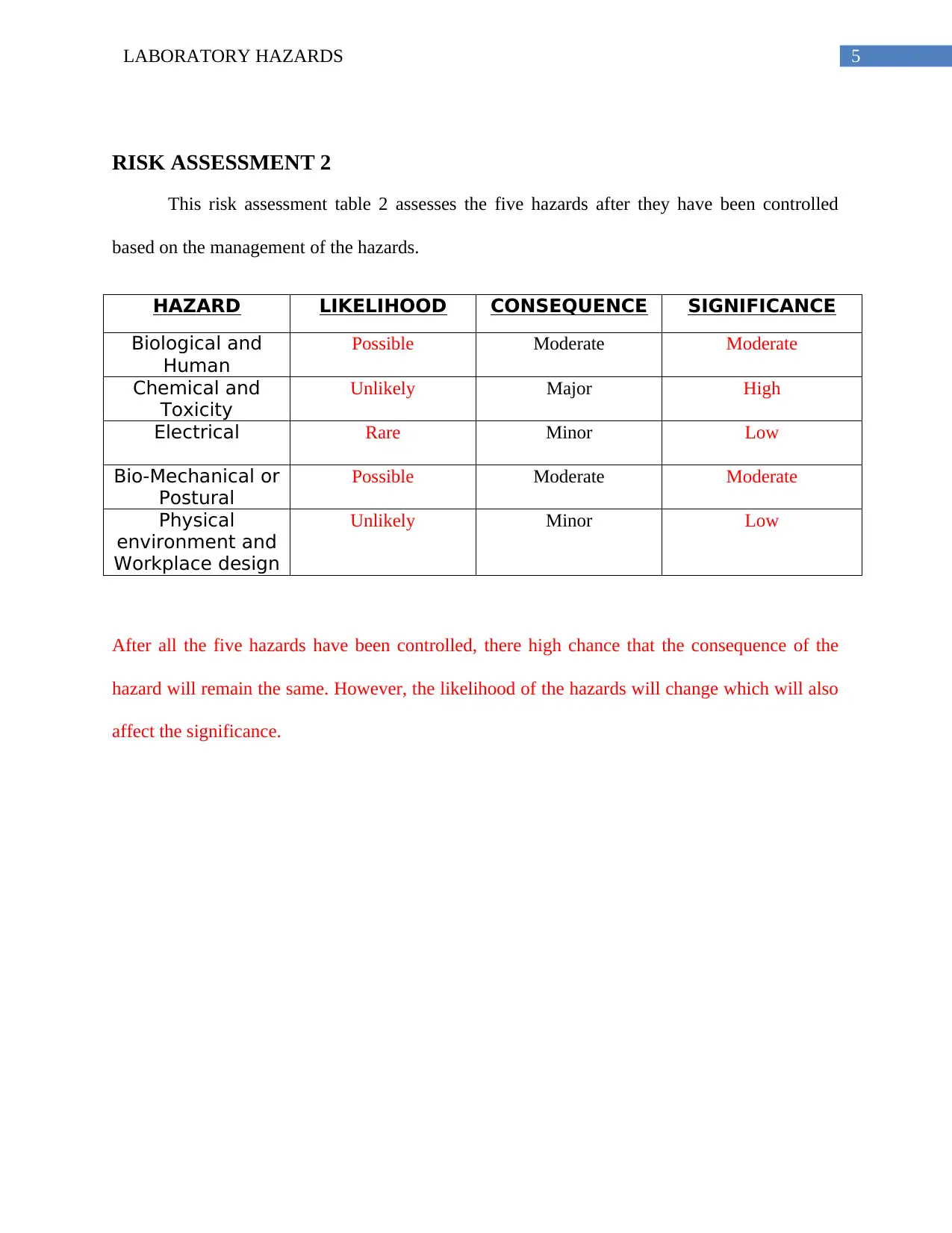
5LABORATORY HAZARDS
RISK ASSESSMENT 2
This risk assessment table 2 assesses the five hazards after they have been controlled
based on the management of the hazards.
HAZARD LIKELIHOOD CONSEQUENCE SIGNIFICANCE
Biological and
Human
Possible Moderate Moderate
Chemical and
Toxicity
Unlikely Major High
Electrical Rare Minor Low
Bio-Mechanical or
Postural
Possible Moderate Moderate
Physical
environment and
Workplace design
Unlikely Minor Low
After all the five hazards have been controlled, there high chance that the consequence of the
hazard will remain the same. However, the likelihood of the hazards will change which will also
affect the significance.
RISK ASSESSMENT 2
This risk assessment table 2 assesses the five hazards after they have been controlled
based on the management of the hazards.
HAZARD LIKELIHOOD CONSEQUENCE SIGNIFICANCE
Biological and
Human
Possible Moderate Moderate
Chemical and
Toxicity
Unlikely Major High
Electrical Rare Minor Low
Bio-Mechanical or
Postural
Possible Moderate Moderate
Physical
environment and
Workplace design
Unlikely Minor Low
After all the five hazards have been controlled, there high chance that the consequence of the
hazard will remain the same. However, the likelihood of the hazards will change which will also
affect the significance.
⊘ This is a preview!⊘
Do you want full access?
Subscribe today to unlock all pages.

Trusted by 1+ million students worldwide
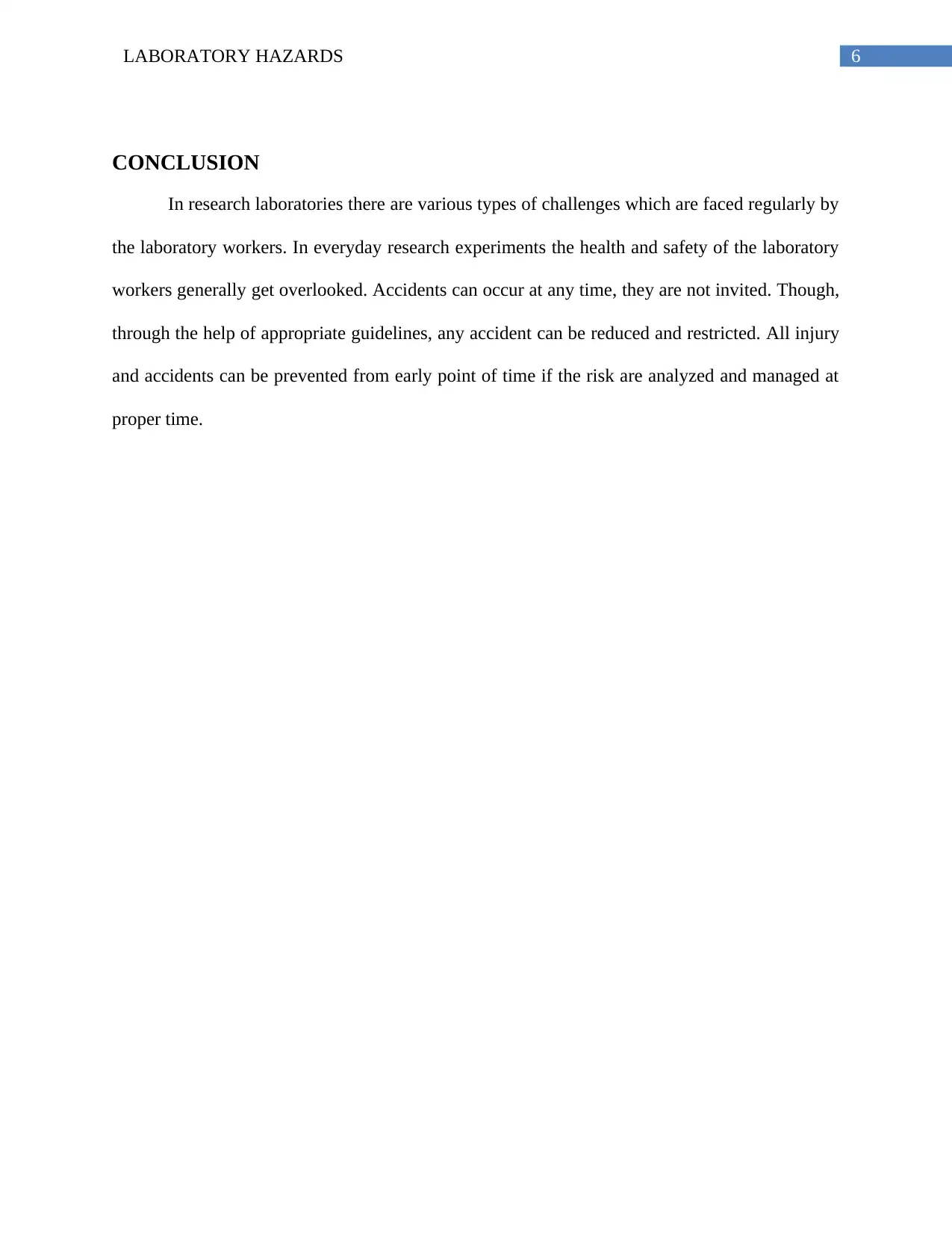
6LABORATORY HAZARDS
CONCLUSION
In research laboratories there are various types of challenges which are faced regularly by
the laboratory workers. In everyday research experiments the health and safety of the laboratory
workers generally get overlooked. Accidents can occur at any time, they are not invited. Though,
through the help of appropriate guidelines, any accident can be reduced and restricted. All injury
and accidents can be prevented from early point of time if the risk are analyzed and managed at
proper time.
CONCLUSION
In research laboratories there are various types of challenges which are faced regularly by
the laboratory workers. In everyday research experiments the health and safety of the laboratory
workers generally get overlooked. Accidents can occur at any time, they are not invited. Though,
through the help of appropriate guidelines, any accident can be reduced and restricted. All injury
and accidents can be prevented from early point of time if the risk are analyzed and managed at
proper time.
Paraphrase This Document
Need a fresh take? Get an instant paraphrase of this document with our AI Paraphraser
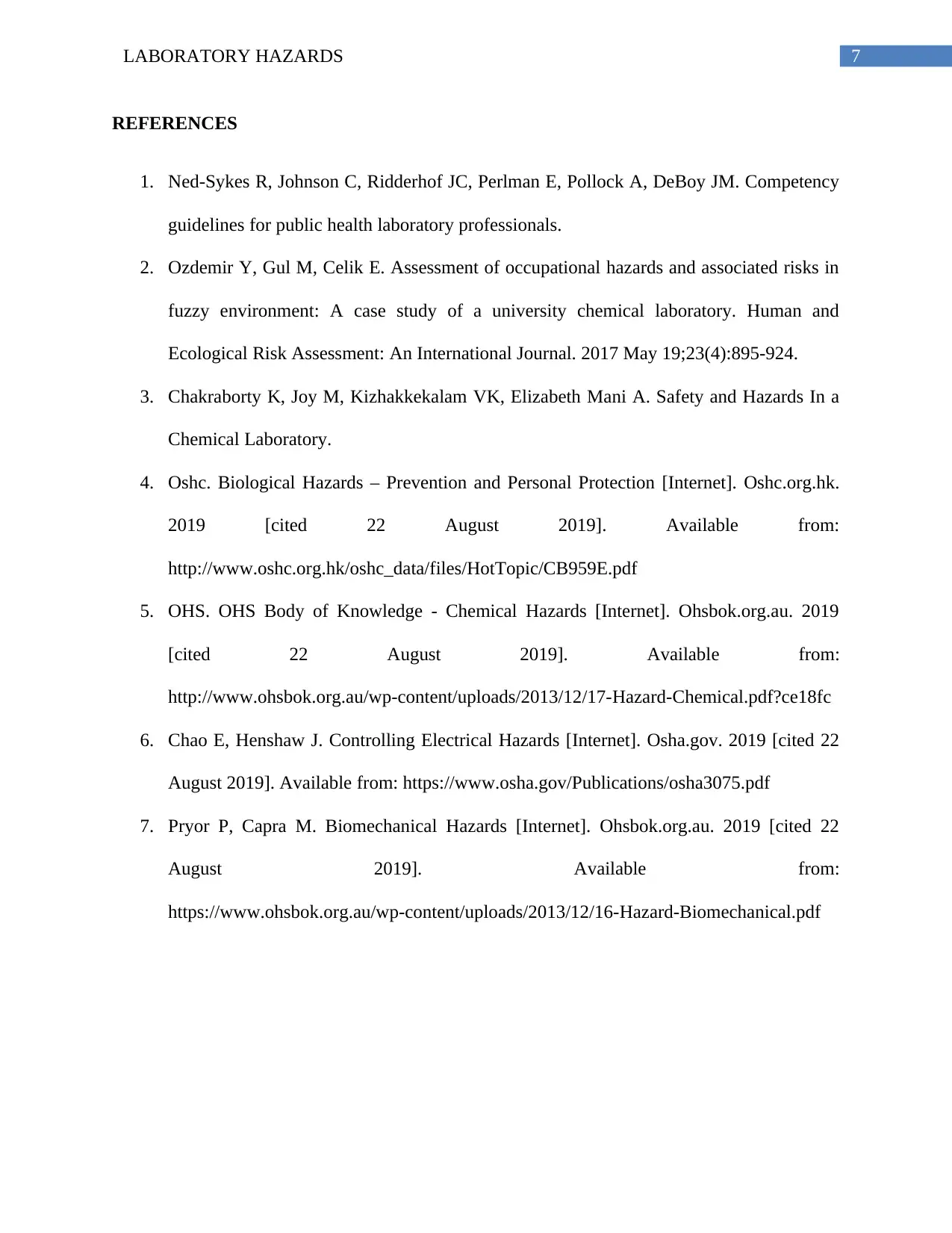
7LABORATORY HAZARDS
REFERENCES
1. Ned-Sykes R, Johnson C, Ridderhof JC, Perlman E, Pollock A, DeBoy JM. Competency
guidelines for public health laboratory professionals.
2. Ozdemir Y, Gul M, Celik E. Assessment of occupational hazards and associated risks in
fuzzy environment: A case study of a university chemical laboratory. Human and
Ecological Risk Assessment: An International Journal. 2017 May 19;23(4):895-924.
3. Chakraborty K, Joy M, Kizhakkekalam VK, Elizabeth Mani A. Safety and Hazards In a
Chemical Laboratory.
4. Oshc. Biological Hazards – Prevention and Personal Protection [Internet]. Oshc.org.hk.
2019 [cited 22 August 2019]. Available from:
http://www.oshc.org.hk/oshc_data/files/HotTopic/CB959E.pdf
5. OHS. OHS Body of Knowledge - Chemical Hazards [Internet]. Ohsbok.org.au. 2019
[cited 22 August 2019]. Available from:
http://www.ohsbok.org.au/wp-content/uploads/2013/12/17-Hazard-Chemical.pdf?ce18fc
6. Chao E, Henshaw J. Controlling Electrical Hazards [Internet]. Osha.gov. 2019 [cited 22
August 2019]. Available from: https://www.osha.gov/Publications/osha3075.pdf
7. Pryor P, Capra M. Biomechanical Hazards [Internet]. Ohsbok.org.au. 2019 [cited 22
August 2019]. Available from:
https://www.ohsbok.org.au/wp-content/uploads/2013/12/16-Hazard-Biomechanical.pdf
REFERENCES
1. Ned-Sykes R, Johnson C, Ridderhof JC, Perlman E, Pollock A, DeBoy JM. Competency
guidelines for public health laboratory professionals.
2. Ozdemir Y, Gul M, Celik E. Assessment of occupational hazards and associated risks in
fuzzy environment: A case study of a university chemical laboratory. Human and
Ecological Risk Assessment: An International Journal. 2017 May 19;23(4):895-924.
3. Chakraborty K, Joy M, Kizhakkekalam VK, Elizabeth Mani A. Safety and Hazards In a
Chemical Laboratory.
4. Oshc. Biological Hazards – Prevention and Personal Protection [Internet]. Oshc.org.hk.
2019 [cited 22 August 2019]. Available from:
http://www.oshc.org.hk/oshc_data/files/HotTopic/CB959E.pdf
5. OHS. OHS Body of Knowledge - Chemical Hazards [Internet]. Ohsbok.org.au. 2019
[cited 22 August 2019]. Available from:
http://www.ohsbok.org.au/wp-content/uploads/2013/12/17-Hazard-Chemical.pdf?ce18fc
6. Chao E, Henshaw J. Controlling Electrical Hazards [Internet]. Osha.gov. 2019 [cited 22
August 2019]. Available from: https://www.osha.gov/Publications/osha3075.pdf
7. Pryor P, Capra M. Biomechanical Hazards [Internet]. Ohsbok.org.au. 2019 [cited 22
August 2019]. Available from:
https://www.ohsbok.org.au/wp-content/uploads/2013/12/16-Hazard-Biomechanical.pdf
1 out of 8
Your All-in-One AI-Powered Toolkit for Academic Success.
+13062052269
info@desklib.com
Available 24*7 on WhatsApp / Email
![[object Object]](/_next/static/media/star-bottom.7253800d.svg)
Unlock your academic potential
Copyright © 2020–2025 A2Z Services. All Rights Reserved. Developed and managed by ZUCOL.